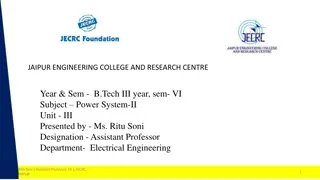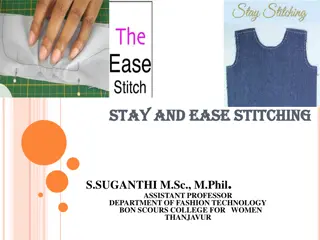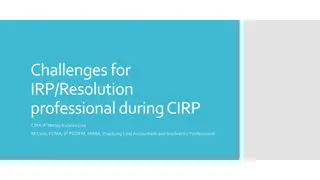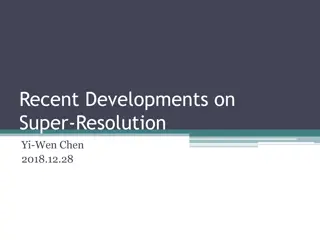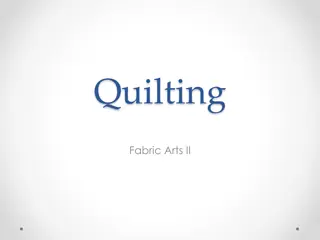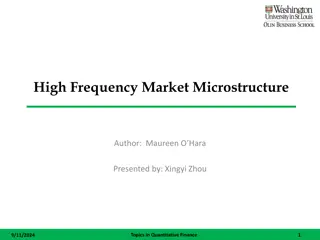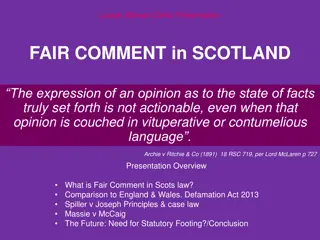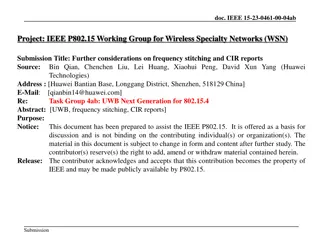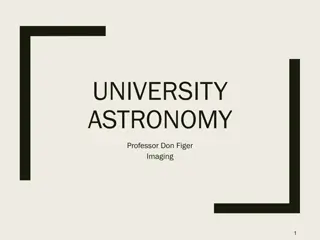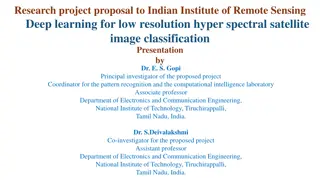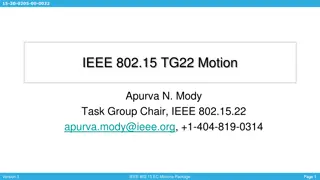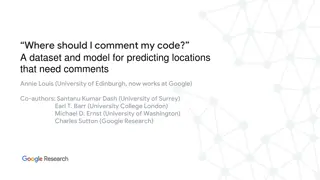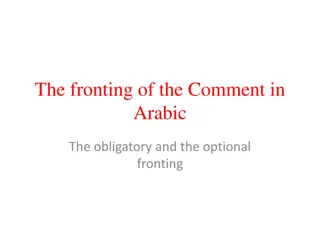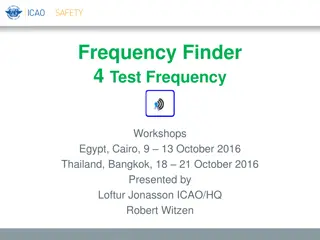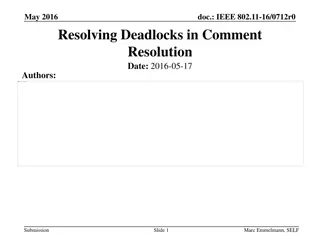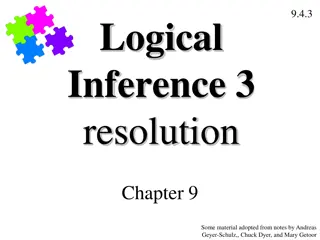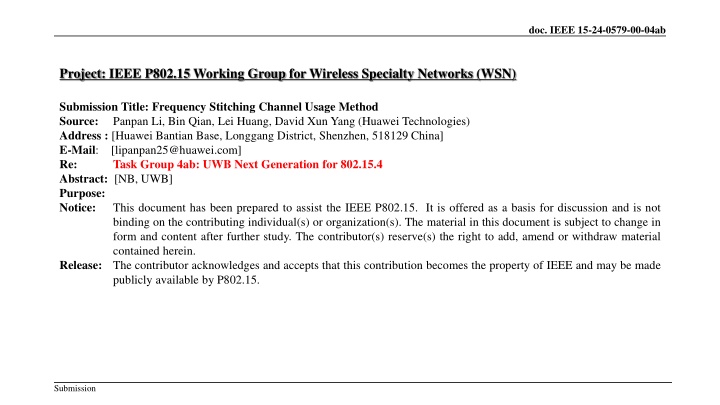
Frequency Stitching Channel Usage Method in UWB Next Generation
Explore the Frequency Stitching Channel Usage Method for UWB in the context of IEEE 802.15 Working Group, focusing on overlapping, channel sequencing, transmission formulas, stitching types, and recent raised problems in the CID discussions.
Uploaded on | 2 Views
Download Presentation

Please find below an Image/Link to download the presentation.
The content on the website is provided AS IS for your information and personal use only. It may not be sold, licensed, or shared on other websites without obtaining consent from the author. If you encounter any issues during the download, it is possible that the publisher has removed the file from their server.
You are allowed to download the files provided on this website for personal or commercial use, subject to the condition that they are used lawfully. All files are the property of their respective owners.
The content on the website is provided AS IS for your information and personal use only. It may not be sold, licensed, or shared on other websites without obtaining consent from the author.
E N D
Presentation Transcript
doc. IEEE 15-24-0579-00-04ab Project: IEEE P802.15 Working Group for Wireless Specialty Networks (WSN) Submission Title: Frequency Stitching Channel Usage Method Source: Panpan Li, Bin Qian, Lei Huang, David Xun Yang (Huawei Technologies) Address : [Huawei Bantian Base, Longgang District, Shenzhen, 518129 China] E-Mail: [lipanpan25@huawei.com] Re: Task Group 4ab: UWB Next Generation for 802.15.4 Abstract: [NB, UWB] Purpose: Notice: This document has been prepared to assist the IEEE P802.15. It is offered as a basis for discussion and is not binding on the contributing individual(s) or organization(s). The material in this document is subject to change in form and content after further study. The contributor(s) reserve(s) the right to add, amend or withdraw material contained herein. Release: The contributor acknowledges and accepts that this contribution becomes the property of IEEE and may be made publicly available by P802.15. Submission
Oct. 2024 doc. IEEE 15-24-0579-00-04ab Recap of Frequency Stitching The Carrier Frequency Grid field 0: no overlap of adjacent frequency stitching channels 1: 25% overlap of adjacent frequency stitching channels 2: 50% overlap of adjacent frequency stitching channels 3: 75% overlap of adjacent frequency stitching channels The Channel Sequence Order field 0: if the Frequency Stitching Direction field is one, the channels used are selected in sequence starting at the channel defined by the Base Channel field value and increasing in frequency using the step size defined by the Carrier Frequency Grid field value. On the other hand, if the Frequency Stitching Direction field is zero, the channels used are selected in sequence starting at the channel defined by the Base Channel field value and decreasing in frequency using the step size defined by the Carrier Frequency Grid field value. 1: the channel used for the p-th transmission is selected according to the formula: CH( ((p (OF+1)) MOD (N)) + ((p (OF +1)) DIV (N)) ), The Number of Transmissions field value plus one, is the total number of transmissions to be done at the different channel center frequencies. The Frequency Stitching Type field 0: Intra-packet frequency stitching 1: Inter-packet frequency stitching 2: Combination of intra-packet frequency stitching and inter-packet frequency stitching 3: Reserved Slide 2 Submission Panpan Li, Huawei
Oct. 2024 doc. IEEE 15-24-0579-00-04ab Problems raised in CID 901, 1253, 264 Problem 1 (CID 901, 1253): missing the transmission of SHR in each sensing packet Problem 2 (CID 264): formula CH( ((p (OF+1)) MOD (N)) + ((p (OF +1)) DIV (N)) ) need to be revised Index # Commenter 901 Carl Murray Sub-Clause 10.39.6.1 Page Line 150 Comment Proposed Change 11 "Figure 160 and the associated text is incomplete as it does not address the SHR of the sensing packet. What happens if the SHR overlaps an SF (of its owns SFs or another packets). Figure 160 is misleading since it is not showing the sensing packet completely with SHR, and the 4 sensing segments. The example does not match formula on p149 for OF=2, N=6 Update the figure to include the SHR and describe the spacing when the SHR overlaps an SF. Billy Verso 10.39.6.1 150 11 Update figure to show full sensing packet(s) with SHR 1253 Li-Hsiang Sun 10.39.6.1 150 4 fix the formula, the (OF+1) in formula for OF=1,2 should be replace by a value of (1+1), i.e. there is 1 overlapping channel in the grid to a base channel for the case of OF=1 and 2 so for these 2 cases the order should be the same 264 Note that adjacent transmission with no more than 25% overlapping won t cause PSD accumulation. The interval between overlapping transmissions with more than 25% overlapping is greater than or equal to 1 ms. Submission Slide 3 Panpan Li, Huawei
Oct. 2024 doc. IEEE 15-24-0579-00-04ab Proposed Solution In the following, we try to solve the above problems from two aspects Simple modifications on Intra-packet frequency stitching Combination of intra-packet frequency stitching and inter-packet frequency stitching We assume every sensing packet have four sensing segments. Submission Slide 4 Panpan Li, Huawei
Oct. 2024 doc. IEEE 15-24-0579-00-04ab Aspect 1: Intra-packet frequency stitching SHR is transmitted first, the last sensing segment is transmitted at same logic channel with SHR N channels: N+1 transmissions (1 SHR and N sensing segments) The Channel Sequence Order field 0: In-sequence channel order, the channel used for the p-th transmission is selected according to the formula: CH( p MOD (N) ), p=0:N 1: Out-of-sequence channel order, the channel used for the p-th transmission is selected according to the formula: CH( (((p MOD(N)) (OF+1)) MOD (N)) + (((p MOD(N)) (OF+1)) DIV (N)) ), p=0:N Frequency Frequency Frequency Sensing segment 3 CH3 1 ms 1 ms 1 ms 1 ms Sensing segment 2 CH2 Sensing segment 3 Sensing segment 1 CH3 CH3 Sensing segment 1 Sensing segment 2 Sensing segment 3 CH1 CH2 CH2 Sensing segment 1 Sensing segment 2 CH1 CH1 Sensing segment 4 Sensing segment 4 Sensing segment 4 CH0 SHR SHR CH0 SHR CH0 Time Time Time OF=0, The Channel Sequence Order field=0 OF=2, The Channel Sequence Order field=1 OF=2, The Channel Sequence Order field=0 Submission Slide 5 Panpan Li, Huawei
Oct. 2024 doc. IEEE 15-24-0579-00-04ab Aspect 2: Combination of intra-packet and inter-packet Propose to reverse the order of channel usage when switching the sensing packet when the Channel Sequence Order field is 1. N channels: 1.25*N transmissions (1 SHR and N/4 sensing segments in every sensing packet) The Channel Sequence Order field 0: In-sequence channel order, the channel used for the p-th transmission is selected according to the formula: CH( q MOD (N) ), q= 4*(p DIV(5))+((p MOD(5)) MOD(4)), p=0:1.25*N-1 1: Out-of-sequence channel order, the channel used for the p-th transmission is selected according to the formula: CH( ((q OF) MOD (N)) + ((q OF) DIV (N)) ), q= 4*(p DIV(5))+((p MOD(5)) MOD(4)), if (p DIV(5)) is odd, q= 4*(p DIV(5))+ 3-((p MOD(5)) MOD(4)), if (p DIV(5)) is even, p=0:1.25*N-1 Time Submission Slide 6 Panpan Li, Huawei
Oct. 2024 doc. IEEE 15-24-0579-00-04ab Aspect 2: Examples N=8 p 0 1 2 3 4 5 6 7 8 9 N=8 q 0 1 2 3 0 4 5 6 7 4 p 0 1 2 3 4 5 6 7 8 9 q 0 1 2 3 0 7 6 5 4 7 Frequency >=1 ms CH7 >=1 ms SEG 3 Frequency CH6 SEG 2 CH5 SEG 4 CH7 SHR SEG 1 SEG 3 CH6 CH4 SEG 4 SHR SEG 1 CH5 CH3 SEG 2 CH4 SEG 3 SEG 2 CH3 CH2 SEG 2 SEG 1 CH2 SEG 1 CH1 SEG 3 CH1 SEG 4 CH0 SHR SEG 4 CH0 SHR Time Time OF=1, The Channel Sequence Order field=0 OF=2, The Channel Sequence Order field=1 Submission Slide 7 Panpan Li, Huawei
Oct. 2024 doc. IEEE 15-24-0579-00-04ab Aspect 2: Benefits Simply extending aspect 1 to multiple packets may still require long transmission time between the last sensing segment and the SHR of next sensing packet. Proposed aspect 2 further reduce the transmission time. >=1 ms >=1 ms Frequency Frequency SEG 3 CH7 SEG 4 CH7 SHR SEG 3 CH6 SEG 3 CH6 SEG 2 CH5 SEG 1 CH5 SEG 2 CH4 SEG 2 CH4 SEG 1 CH3 SEG 2 CH3 SEG 1 CH2 SEG 1 CH2 SEG 4 CH1 SHR SEG 3 CH1 SEG 4 CH0 SHR SEG 4 CH0 SHR Time Time Proposed scheme If simply extend aspect 1 Submission Slide 8 Panpan Li, Huawei
Oct. 2024 doc. IEEE 15-24-0579-00-04ab Summary We revised the existing frequency stitching channel usage method considering the existence of SHR. Submission Slide 9 Panpan Li, Huawei

